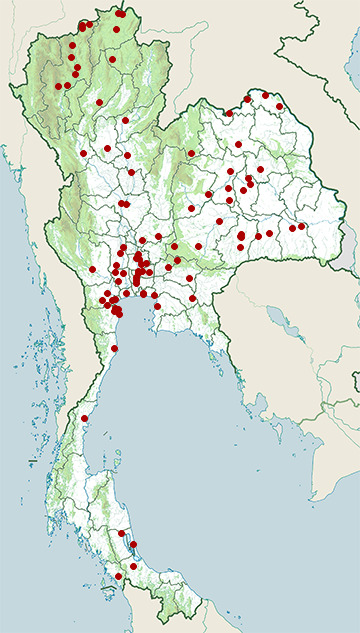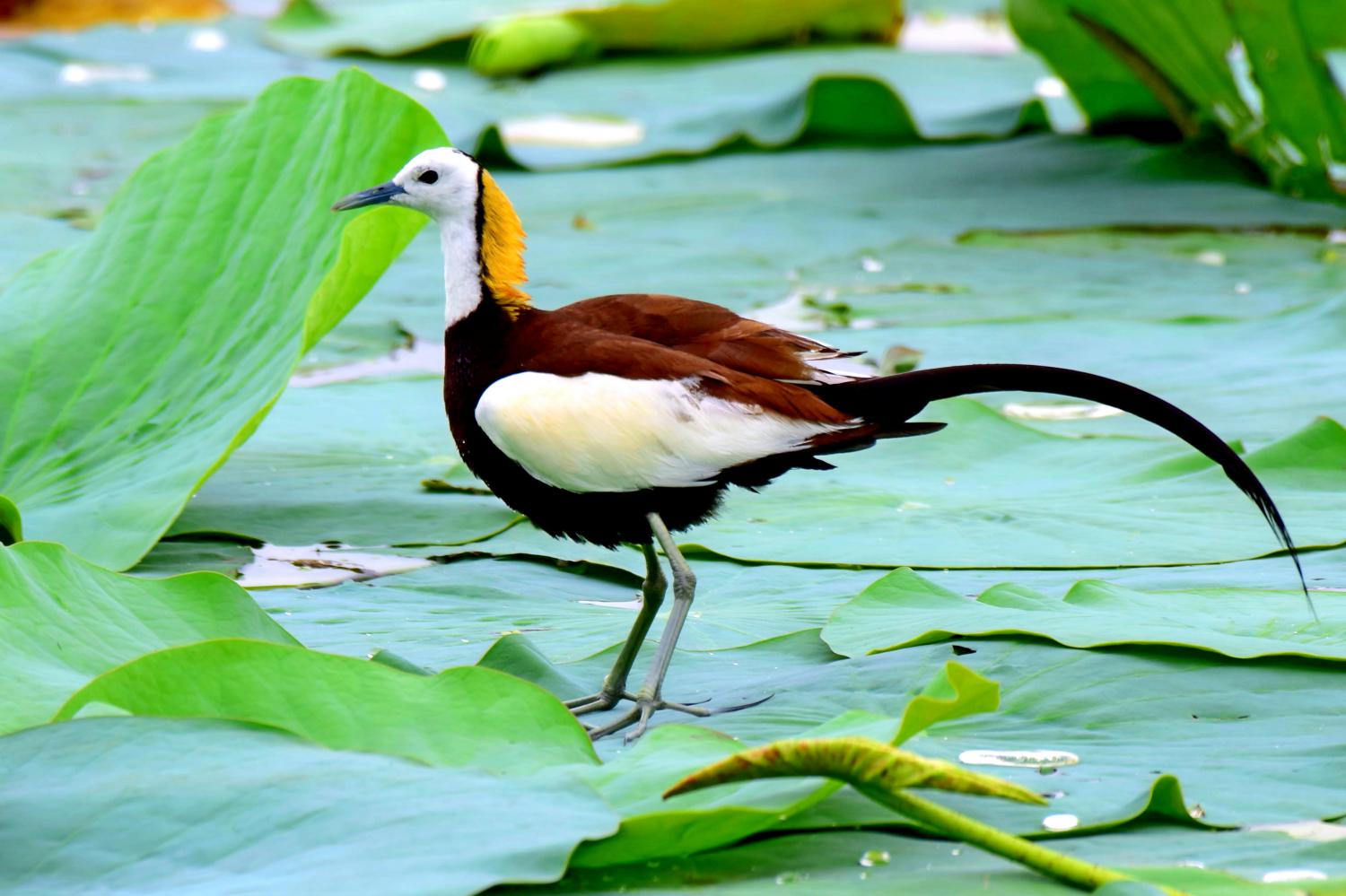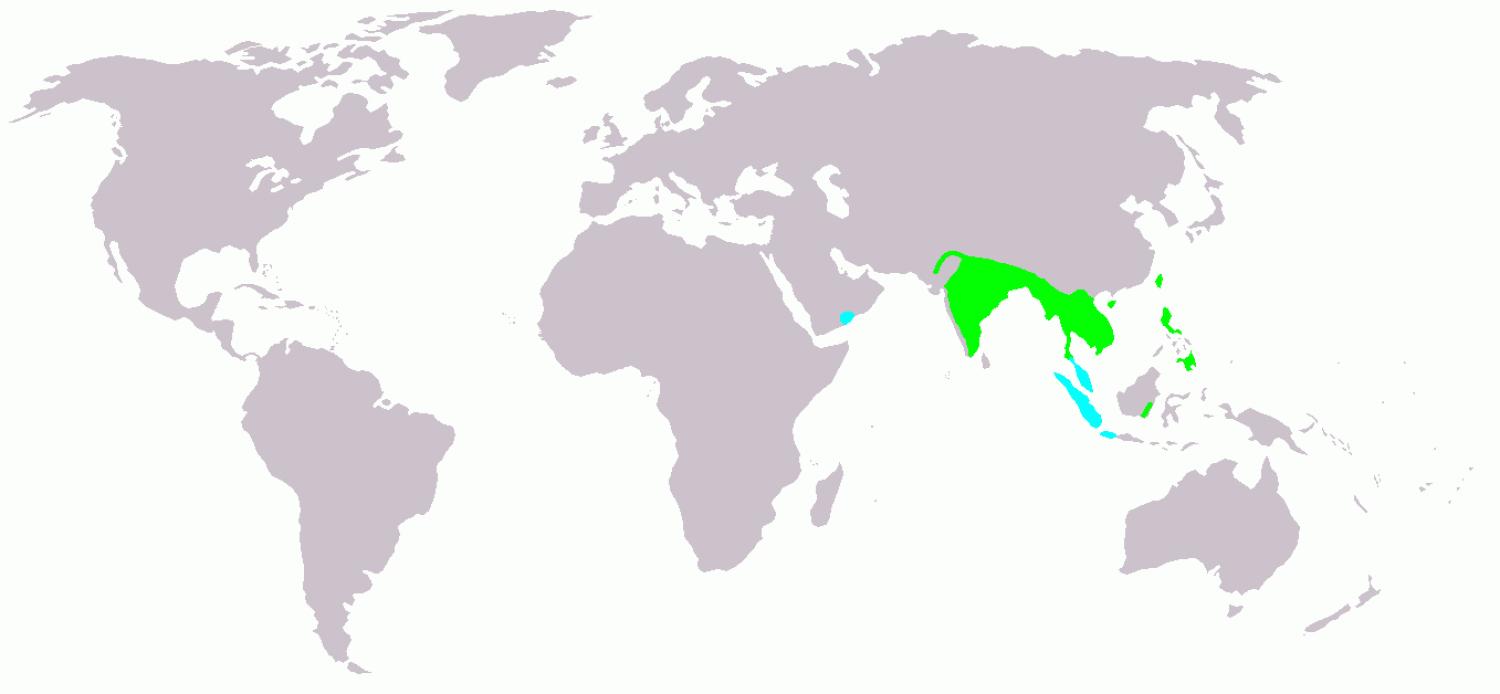Species of Thailand
Pheasant-tailed jacana
Hydrophasianus chirurgus
Giovanni Antonio Scopoli, 1786
In Thai: นกอีแจว
The pheasant-tailed jacana (Hydrophasianus chirurgus) is a jacana in the monotypic genus Hydrophasianus. Like all other jacanas they have elongated toes and nails that enable them to walk on floating vegetation in shallow lakes, their preferred habitat. They may also swim or wade in water reaching their body while foraging mainly for invertebrate prey. They are found in tropical Asia from Yemen in the west to the Philippines in the east and move seasonally in parts of their range. They are the only jacanas that migrate long distances and with different non-breeding and breeding plumages. The pheasant-tailed jacana forages by swimming or by walking on aquatic vegetation. Females are larger than the males and are polyandrous, laying several clutches that are raised by different males in their harem.
Description
The pheasant-tailed jacana is conspicuous and unmistakable, and lengthwise, the largest in the jacana family when the tail streamers are included. This is the only jacana to have a different breeding and non-breeding plumages. The breeding plumage is marked by the elongated central tail feathers that given the bird its name. The body is chocolate brown, with a white face and the back of the crown is black with white stripes running down the sides of the neck that separate the white of the front of neck and the silky golden yellow of the nape. The wings are predominantly white. In flight the white wing shows a black border formed by black on the outermost primaries and the tips of the outer secondaries and the primaries. The wing coverts are pale brown and the scapulars may be glossed green or purple. In the non-breeding season the top of the head and back are dark brown and only a trace of the golden nape feathers may be seen. A dark eyestripe runs down the sides of the neck and forms a dark necklace on a slightly sullied white front. The outer two primaries have a slender (lanceolate or spatulate) extension that broadens at the tip. The fourth primary has an acute tip formed by the shaft after the loss of webbing. Young birds have brown upper parts and the dark necklace is broken. Some traces of the black stripe on the side of the neck and white wings separate them from somewhat similar looking immatures of the bronze-winged jacana. They have strongly developed sharp white carpal spurs which are longer in females. The spurs may also undergo moult but has not been specifically described in this species. The tail is short and strongly graduated. The bill is more slender than in the bronze-winged and is bluish-black with a yellow tip when breeding and dull brown with yellowish base when not breeding. The leg is dark bluish grey and the iris is brown.
Shufeldt described the skeletal features of a specimen from Luzon as being typical of jacanas but that the skull resembles in some ways to those of sandpipers. The skull and mandibles are slightly pneumatized unlike other bones and the sternum has a notch on the side which serve as attachment points to long and slender xiphoidal processes.
Taxonomy and systematics
The pheasant-tailed jacana was described by the French explorer Pierre Sonnerat in his 1776 Voyage à la Nouvelle Guinée in which he included an illustration of the bird that he called "Le Chirurgien de l'Isle de Luzon" or the surgeon of the island of Luzon. He described the bird with the long toes, the elongated feather extensions resembling the lancets used for blood-letting by surgeons of the period. Based on this description, the bird was given a binomial by Giovanni Scopoli in 1787 in his Deliciae florae et faunae Insubricae (Pars II) where he placed it in the genus Tringa. He retained the name chirurgus for the specific name. It was later placed in the genus Parra (also with the junior name Parra luzonensis) along with other jacanas and still later, the genera within the jacana family (then called Parridae) were separated.
The genus Hydrophasianus meaning "water pheasant" was erected by Johann Georg Wagler in 1832 as the species was distinctive in having a slender bill, lacking any frontal lappet, having a shorter hind claw than Metopidius, and the outer two primaries bearing lanceolate elongations and the fourth primary being pointed. The distinct breeding and non-breeding plumage is unique within the jacanas.
Measurements
The following are standard bird measurements from a study that is based on living specimens during the breeding season in Thailand and are averaged from 17 males and 4 females. A few measurements are from Rasmussen and Anderton (2005) where the head measurement (range given rather than mean) is from the tip of the bill to the back of the skull.
| colspan="3" | Measurements | ||
|---|---|---|
| Males | Female | |
| mass (g) | 129.2 | 140.7 |
| bill (cm) | 2.89 | 3.12 |
| wing (cm) | 24.76 | 25.83 |
| tarsus (cm) | 5.72 | 6.33 |
| tail (cm) | 25.75 | 28.34 |
| head (cm) | 5.3-5.5 | 5.8-6.3 |
| length (cm) | 45.91 | 50.27 |
Body mass measurements can vary widely based on physiological conditions and is generally not used for taxonomic purposes. A dataset from the Philippines gives the body mass ranges as 120 - 140 g in males and 190 - 200 g for females.
Distribution and habitat
The pheasant-tailed jacana is a resident breeder in tropical India, Southeast Asia, and Indonesia and it overlaps greatly with the range of the bronze-winged jacana but unlike the bronze-winged jacana, this species is found in Sri Lanka. It is found on small to large lakes having sufficient floating vegetation on them. It is sedentary in much of its range, but northern breeders from south China and the Himalayas migrate south of their ranges to Southeast Asia and Peninsular India respectively. In Nanking, the birds leave in November and return in summer in the third week of April. Some birds arrive in the non-breeding plumage. It is also resident in Taiwan, where it is considered endangered. Birds disperse in summer and have been recorded as vagrants in Socotra, Qatar, Australia and southern Japan. The species tends to be commoner in lower elevations but they climb into the Himalayas in summer and records exist of the species from altitudes of 3650 m in Kashmir (Vishansar Lake) and 3800 m in Lahul.
Behaviour and ecology
The pheasant-tailed jacana's main sources of food are insects, molluscs, and other invertebrates picked from the floating vegetation or the water's surface. The forage by walking on vegetation and also by swimming in water, somewhat like phalaropes (Hoffmann claims that they wade in deeper water but never swim). They also ingest filamentous algae, seeds and plant material but this may be purely accidental. Flocks of as many as 50 to 100 can be found on a waterbody and they can become very tame and habituated to human presence. They usually fly low over the water surface but may also mob raptors higher in the air and on landing, keep their wings open until they find firm footing.
The typical call is a mewing me-onp or a nasal teeun among winter flocks. Males and females have different calls during the breeding season and several contextual variants exist. Young birds produce a low cheep with the bill closed.
Breeding
These jacanas breed on floating vegetation during the rainy season. In southern India, it breeds in the monsoon season, June–September. They are polyandrous and a female may lay up to 10 clutches in a single season that are raised by different males. Female court males with flight displays around the males along with calling. The female builds a nest on floating vegetation made of leaves and stalks of plants with a depression in the centre. A single clutch consists of four glossy black-marked dark-olive-brown eggs (occasionally an egg in a clutch may be an odd pale sea-green in colour) which are laid in the mornings in 24 hour intervals between each egg. When an egg was removed at the one or two egg stage, the nest would be torn down and a new one built but a removal at the last egg stage did not result in replacement. Once the clutch of four is laid, the male begins incubation and the female goes away to court a different male. In a study in Thailand it was found that it took a female 17 to 21 days to lay the next clutch. A study in China found females taking 9-12 days and laying nearly 7 to 10 clutches in a season. Males may move or drag eggs around by holding them between the bill and breast or between the wings and body. They may also push and float the eggs over water and onto nearby vegetation platforms when disturbed. Nests may be moved to distances of about 15 metres.
Males near the nest may also perform broken-wing and rodent-run displays to distract attention of predators. The eggs are incubated for 26 to 28 days. During the first few days of incubation, the female defends the nest, chasing other waterbirds that may approach too close by flying at them. In close territorial combat they lock bills and strike simultaneously with both wings. Males actively forage in the morning and afternoon and tend to sit at the nest during the hottest part of the day. The downy nidifugous chicks freeze when threatened or when the male indicates alarm and may lie partly submerged with just the bill out of water.
Eggs may be preyed on by pond herons, while chicks may bet taken by birds of prey such as black-winged kites. The trematode parasite Renicola philippinensis was described from the kidney of a specimen of the pheasant-tailed jacana in the New York zoological garden while Cycloceolum brasilianum was recorded in India. The bird louse species Rallicola sulcatus has been described from this species which looks very similar to Rallicola indicus from the bronze-winged jacana. Another bird louse known from the species is Pseudomenopon pilosum.
In culture
The pheasant-tailed jacana is commonly distributed in lily ponds in Sri Lanka and on account of its mewing call is known as the "cat teal" or juana in Sinhalese. In Cachar district of Assam, it is known by the name of which translates to "Little White Water Princess".
This article uses material from Wikipedia released under the Creative Commons Attribution-Share-Alike Licence 3.0. Eventual photos shown in this page may or may not be from Wikipedia, please see the license details for photos in photo by-lines.
Category / Seasonal Status
Wiki listed status (concerning Thai population): Winter visitor and resident
BCST Category: Recorded in an apparently wild state within the last 50 years
BCST Seasonal statuses:
- Resident or presumed resident
- Non-breeding visitor
Scientific classification
- Kingdom
- Animalia
- Phylum
- Chordata
- Class
- Aves
- Order
- Charadriiformes
- Family
- Jacanidae
- Genus
- Hydrophasianus
- Species
- Hydrophasianus chirurgus
Common names
- English: Pheasant-tailed acana
- French: Jacana à longue queue
- Thai: นกอีแจว
Conservation status

Least Concern (IUCN3.1)
Photos
Please help us review the bird photos if wrong ones are used. We can be reached via our contact us page.
Range Map

- Amphawa District, Samut Songkhram
- Ban Laem District, Phetchaburi
- Ban Phai District, Khon Kaen
- Bang Ban District, Phra Nakhon Si Ayutthaya
- Bang Len District, Nakhon Pathom
- Bang Pa In District, Phra Nakhon Si Ayutthaya
- Bang Pahan District, Phra Nakhon Si Ayutthaya
- Bang Pakong District, Chachoengsao
- Bang Phra Non-Hunting Area
- Bang Pu Recreation Centre
- Bangkok Province
- Borabue District, Maha Sarakham
- Bueng Boraped Non-Hunting Area
- Bueng Khong Long Non-Hunting Area
- Chatturat District, Chaiyaphum
- Chiang Dao District, Chiang Mai
- Chiang Saen District, Chiang Rai
- Doi Inthanon National Park
- Doi Lo District, Chiang Mai
- Doi Pha Hom Pok National Park
- Fang District, Chiang Mai
- Hat Yai District, Songkhla
- Huai Chorakhe Mak Reservoir Non-Hunting Area
- Huai Talat Reservoir Non-Hunting Area
- Kabin Buri District, Prachinburi
- Kamphaeng Saen District, Nakhon Pathom
- Kanthararom District, Sisaket
- Kantharawichai District, Maha Sarakham
- Khao Ang Rue Nai Wildlife Sanctuary
- Khao Sam Roi Yot National Park
- Khao Yai National Park
- Khao Yoi District, Phetchaburi
- Khlong Luang District, Pathum Thani
- Kumphawapi District, Udon Thani
- Kut Thing Non-Hunting Area
- Laem Pak Bia
- Mae Ai District, Chiang Mai
- Mae Taeng District, Chiang Mai
- Mae Tha, Lampang District, Lampang
- Mueang Buriram District, Buriram
- Mueang Chiang Mai District, Chiang Mai
- Mueang Kalasin District, Kalasin
- Mueang Kanchanaburi District, Kanchanaburi
- Mueang Khon Kaen District, Khon Kaen
- Mueang Lopburi District, Lopburi
- Mueang Maha Sarakham District, Maha Sarakham
- Mueang Nakhon Pathom District, Nakhon Pathom
- Mueang Nakhon Sawan District, Nakhon Sawan
- Mueang Nong Khai District, Nong Khai
- Mueang Nonthaburi District, Nonthaburi
- Mueang Phayao District, Phayao
- Mueang Phetchaburi District, Phetchaburi
- Mueang Phichit District, Phichit
- Mueang Phitsanulok District, Phitsanulok
- Mueang Ratchaburi District, Ratchaburi
- Mueang Samut Sakhon District, Samut Sakhon
- Mueang Samut Songkhram District, Samut Songkhram
- Mueang Sisaket District, Sisaket
- Mueang Sukhothai District, Sukhothai
- Mueang Suphanburi District, Suphan Buri
- Mueang Surin District, Surin
- Mueang Tak District, Tak
- Mueang Uttaradit District, Uttaradit
- Nong Bong Khai Non-Hunting Area
- Nong Plak Phra Ya – Khao Raya Bangsa Non-Hunting
- Nong Song Hong District, Khon Kaen
- Nong Waeng Non-Hunting Area
- Nong Yai Area Development Project Under Royal Init
- Pak Chong District, Nakhon Ratchasima
- Pak Kret District, Nonthaburi
- Pak Phli District, Nakhon Nayok
- Pak Thale
- Pak Tho District, Ratchaburi
- Pak Thong Chai District, Nakhon Ratchasima
- Pathum Thani Province
- Phatthana Nikhom District, Lopburi
- Phimai District, Nakhon Ratchasima
- Phra Nakhon Si Ayutthaya District, Phra Nakhon Si Ayutthaya
- Phu Kradueng District, Loei
- Rattanawapi District, Nong Khai
- Samut Prakan Province
- San Sai District, Chiang Mai
- Sanam Bin Reservoir Non-Hunting Area
- Sathing Phra District, Songkhla
- Si Prachan District, Suphan Buri
- Sikhoraphum District, Surin
- Song Phi Nong District, Suphan Buri
- Thale Noi Non-Hunting Area
- Thanyaburi District, Pathum Thani
- Wang Noi District, Phra Nakhon Si Ayutthaya
- Wat Phai Lom & Wat Ampu Wararam Non-Hunting Area
- Wiang Chai District, Chiang Rai




